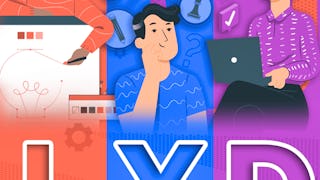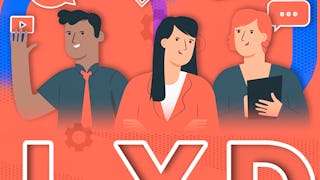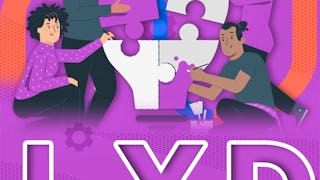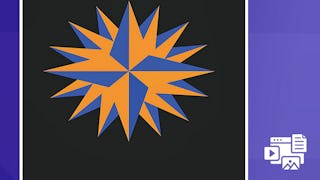In Theories and Frameworks, you’ll take a close look at learners and learning contexts. As you define your target audience, you’ll learn how to use learner personas as a communication tool with stakeholders and how these can be used to influence learning goals, assessments, and activities.


Learning Experience Design: Theories and Frameworks
3,668 人已注册
包含在 中
您将学到什么
Analyze learner needs and learning contexts
Implement taxonomies and theories for design
Align learning outcomes with course outlines
您将获得的技能
要了解的详细信息
了解顶级公司的员工如何掌握热门技能

积累特定领域的专业知识
- 向行业专家学习新概念
- 获得对主题或工具的基础理解
- 通过实践项目培养工作相关技能
- 获得可共享的职业证书

该课程共有4个模块
In Week 1 of the course, you’ll focus on developing a vision of the learner and of the learning context. You’ll revisit ideas from learner-centered design and the “designing for all learners” mindset we discussed in course one. Using a design process frame, you’ll consider the kinds of information you need to gather about your learner audience and context and identify approaches for analyzing this information. Finally, you’ll explore the role of learner personas in aiding decision making with project stakeholders.
涵盖的内容
5个视频10篇阅读材料2个作业1个应用程序项目3个讨论话题
In Week 2 of the course, you’ll focus on different theories and perspectives on learning, and consider ways that these theoretical ideas can inform learning experience design. You will review ideas from overviews of three major learning theories: Behaviorism, Cognitivism, and Constructivism. You will note how different learning theories lead to different ideas about what constitutes learning, and what kind of activities can support learning. You will also look at some perspectives and theories about motivation. You will review ideas about extrinsic and intrinsic motivation, and review Self-Determination Theory to identify different dimensions that can motivate people. All of these ideas can help you see how you might design learning experiences in ways that can motivate learners.
涵盖的内容
6个视频7篇阅读材料3个作业2个应用程序项目2个讨论话题
In Week 3 of the course, you will look at different learning taxonomies (i.e., Bloom’s Taxonomy, Fink’s Taxonomy) that serve as ways of describing knowledge so that we can design learning experiences that include activities for learners that will help them gain that knowledge. You will also look at learning outcomes and see the characteristics of good learning outcomes to help you develop the outcomes that will be the foundation for a learning experience. Finally, you will look at learning design frameworks, which describe specific conceptual approaches that help you as you are shaping a learning experience. These three concepts–learning taxonomies, learning outcomes, and learning design frameworks–-are all related, and you will see the interplay between these to help you describe and develop learning outcomes and learning activities for your designs.
涵盖的内容
6个视频8篇阅读材料3个作业1个应用程序项目3个讨论话题
This week, you will explore the initial phases of the design process that involve brainstorming activities and developing the initial ideas for a new design. You will begin by looking at tools for these ideation and brainstorming activities. We will discuss conceptual tools and how they help articulate and concretize ideas, especially for ideation and brainstorming, and then later for outlining the learning experience you are designing. You will connect to our earlier discussions about the iterative nature of design to see how these tools support design by helping you describe your ideas in order to communicate them to the team and stakeholders, get feedback, and use this to refine and generate new ideas. You will then have a chance to reflect on how these types of activities and tools fit with the LXD core competencies as you think about how you can build these types of skills.
涵盖的内容
3个视频13篇阅读材料1个作业1次同伴评审2个应用程序项目3个讨论话题
获得职业证书
将此证书添加到您的 LinkedIn 个人资料、简历或履历中。在社交媒体和绩效考核中分享。
从 Education 浏览更多内容
 状态:免费试用
状态:免费试用University of Michigan
 状态:免费试用
状态:免费试用University of Michigan
 状态:免费试用
状态:免费试用University of Michigan
人们为什么选择 Coursera 来帮助自己实现职业发展




学生评论
32 条评论
- 5 stars
91.17%
- 4 stars
5.88%
- 3 stars
2.94%
- 2 stars
0%
- 1 star
0%
显示 3/32 个
已于 Mar 24, 2025审阅
General overview with lots of future reading recommendations
常见问题
To access the course materials, assignments and to earn a Certificate, you will need to purchase the Certificate experience when you enroll in a course. You can try a Free Trial instead, or apply for Financial Aid. The course may offer 'Full Course, No Certificate' instead. This option lets you see all course materials, submit required assessments, and get a final grade. This also means that you will not be able to purchase a Certificate experience.
When you enroll in the course, you get access to all of the courses in the Specialization, and you earn a certificate when you complete the work. Your electronic Certificate will be added to your Accomplishments page - from there, you can print your Certificate or add it to your LinkedIn profile.
Yes. In select learning programs, you can apply for financial aid or a scholarship if you can’t afford the enrollment fee. If fin aid or scholarship is available for your learning program selection, you’ll find a link to apply on the description page.
更多问题
提供助学金,
¹ 本课程的部分作业采用 AI 评分。对于这些作业,将根据 Coursera 隐私声明使用您的数据。







